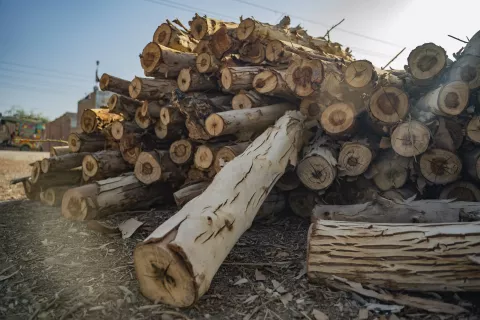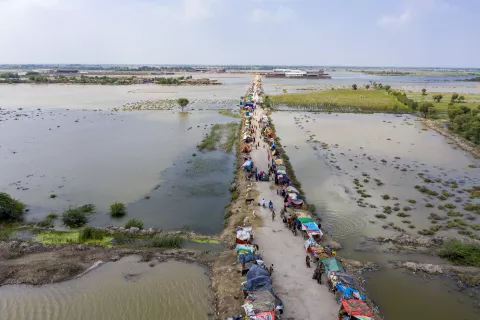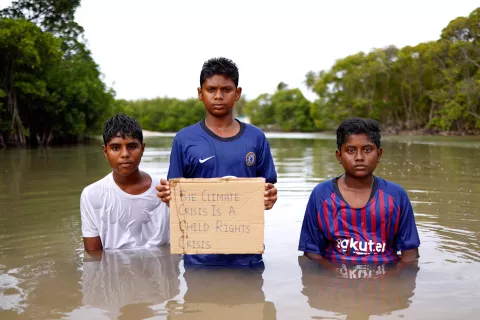Climate change is no longer a looming threat but an urgent global crisis that's disproportionately impacting the most vulnerable children and communities across the world. The South Asia region is a climate hotspot, where its youngest inhabitants, the children, bear the brunt of its devastating impacts. In countries like Afghanistan, Bangladesh, India, Pakistan, and the Maldives, children face extremely high risks due to climate change and environmental degradation.
In South Asia, 76 per cent of children are exposed to soaring temperatures and 600 million are highly vulnerable to vector-borne diseases as well as alarming levels of air pollution. This presents the region with an unprecedented challenge. The situation is worsened by severe water scarcity intensified by climate change, impacting 347 million children – the highest in the world. Astonishingly, despite contributing only 8 per cent of global carbon emissions, South Asia suffers disproportionately from the consequences of climate change.

The paradox of those who contribute least to climate crises facing the severest consequences raises critical questions. Why do these vulnerable children receive inadequate global attention? It's an inequity that concerns me deeply and demands urgent rectification.
What is needed for children?
Children in South Asia deserve governments' unwavering commitment to safeguard their rights to a clean, healthy, and sustainable environment. To achieve this, essential services must adapt, and:
- Compensation for loss and damage needs speedy implementation.
- Disaster risk reduction measures should be amplified.
- Early warning systems must be enhanced.
- Increased investment in decarbonisation is vital.
These actions can serve as the differentiators between survival and disaster for the region's children.


UNICEF’s vision for climate action
UNICEF, in response to this crisis, has laid out a comprehensive Sustainability and Climate Change Action Plan. Central to this plan is the call “to galvanize a global commitment to ensure a sustainable world and to protect the most vulnerable children from the worst impacts of climate change so that every child has an opportunity to survive, grow, and thrive.”
The plan details UNICEF’s organisational approach to this crisis, outlining areas of focus for actions and partnerships. However, it's necessary to recognize that achieving the best results requires collaboration beyond UNICEF's singular efforts.

Priority programmes for UNICEF
UNICEF's priority programmes highlight this commitment. Efforts such as solar electrification of healthcare facilities and schools, extending to remote areas, alongside solutions for better air quality, stress the significance of community involvement in climate action.
In the Maharashtra state of India, UNICEF conducted electricity needs analyses at tribal Primary Health Centres, installing solar hybrid photo-voltaic (PV) systems. These systems facilitated 24/7 healthcare, enabling staff to handle emergencies efficiently, including trauma, poisonings, deliveries, newborn resuscitation, and minor surgeries. The acquired technical knowledge and benefits for children and women led to the expansion to more than 400 systems across nearly 30 districts. This resulted in increased use of medical devices, more cold chain vaccine storage, enhanced health-seeking practices, and improved safety for patients and staff, especially for females during night time hours. As a result of the initiative, 240,000 children benefitted from essential newborn care facilities and access to vaccinations.[1]
In Nepal, UNICEF's community engagement raises awareness about health impacts of air pollution and promotes forest conservation. Support to local governments and communities enhances maternal and child health by addressing indoor air pollution stemming from traditional fuel use in rural areas. This pollution often triggers respiratory illnesses in children. Providing 11,000 households with clean cook stoves across six municipalities has reduced indoor smoke, benefiting nearly 32,000 children. These efficient stoves save time and firewood, empowering women for income generation, while allowing girls to focus on education instead of collecting firewood.
Moreover, youth engagement programmes in Pakistan, Maldives, Sri Lanka, and Bangladesh, underline UNICEF's commitment to skill development and environmental sustainability.
However, urgency is paramount. Over 625 million children in South Asia are on the edge of a health and survival crisis due to climate change. Urgent action is necessary to protect critical services upon which these children depend on; water, sanitation, health, and education. It is equally necessary to equip children with the skills and knowledge to navigate a climate-altered world.
Yet, at the core of all actions lies the pivotal need for global leaders to limit global warming to 1.5 degrees Celsius. Without urgent global action, the climate devastation we have seen in Pakistan will only be a precursor of many more child survival catastrophes to come. This is the only way to safeguard the lives of countless children across South Asia. The urgency cannot be overstated; failure to act now will only lead to more devastation.
[1] UNICEF. "A brighter life for every child with sustainable energy." Published by UNICEF, Climate, Environment, Energy and Disaster Risk Reduction, September 2022.
The importance of climate financing
Children, despite their unique vulnerability to the impacts of climate change, receive minimal support in climate finance, with a mere 2.4 percent allocated to support projects that incorporate child-responsive activities from key multilateral climate funds. Increasing investments tailored to children's needs within climate programmes is imperative. Specifically directing resources toward adapting essential social services for children holds the potential to significantly enhance their health and overall well-being.

A glimmer of hope for children
With world leaders concluding COP28, there’s a glimmer of hope for children. For the first time, COP has acknowledged that children are disproportionately impacted by the climate crises and calls for an expert dialogue dedicated to children and climate change. Children affected by floods in numerous districts of Pakistan continue to wait for the restoration and reconstruction of their schools and safe water systems. The implementation of the Loss and Damage Fund could expedite compensation to communities, allowing the quicker rebuilding of their damaged infrastructure after climate disasters.

In conclusion, the time to act is upon us. The fate of millions of children in South Asia hangs in the balance. Climate change, left unchecked, will lead to irreparable harm. Let's not fail these children. Let's act decisively, urgently, and collectively to secure a liveable future for them. The resilience of our communities and the strength of our economies hinge on our commitment to safeguarding the lives of these children. The question isn't just about climate action; it's about safeguarding the future of humanity itself.
About the Author:
Rakshya R Thapa is the Regional Adviser for Climate and Environment at the UNICEF Regional Office for South Asia. Rakshya leads the support to eight country offices in the region to address the impacts of climate change and environmental degradation on children. Rakshya has worked extensively in the Asia Pacific region and Africa, supporting governments in designing and implementing climate, energy and environmental programmes, and mobilising climate finance from diverse sources, including multilateral, bilateral and private sectors. Before joining ROSA, Rakshya worked with UNICEF New York, UNDP Bangkok Regional Hub and the Asian Development Bank, Manila.





